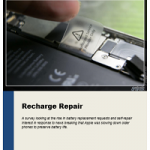Recharge Repair
A survey looking at the rise in battery replacement requests and self-repair interest in response to news breaking that Apple was slowing down older phones to preserve battery life.
Downloads
MASSPIRG

#Throttle Gate and the Barriers to Repair
Consumers should be able to repair what they own. Fixing what you own rather than buying something new can be a more affordable and more ecological choice. But for many products today, repair is made needlessly difficult, and sometimes impossible. As we consider how best to make sure technology benefits our quality of life and avoids needless harm to our environment, we should reduce barriers to repair.
The battery on your phone is one of the few parts of the phone that is guaranteed to wear out. You can carefully keep your screen, headphone and charging ports pristine, but your battery will lose a bit of life on every change. According to Apple, their batteries are designed to retain 80% of their charge after 500 recharges, or about a year and 4 months of daily charging.
Even though after a few years of regular use phones need a new battery to last the day, Apple does not sell their replacement batteries to customers or third parties. Only Apple authorized technicians are permitted to replace your iPhone’s battery with the original part, which they offer for $79 plus shipping.
In December of 2017, users began to complain about how a new software update to Apple iPhones appeared to slow down their device, while others noted it appeared to happen to those devices with older batteries, and was fixed by swapping the battery out. This was confirmed by tests run by Primate Labs founder John Poole, reported on Dec. 18. On Dec. 20, Apple issued a statement to TechCrunchv addressing the issues identified by users:
Our goal is to deliver the best experience for customers, which includes overall performance and prolonging the life of their devices. Lithium-ion batteries become less capable of supplying peak current demands when in cold conditions, have a low battery charge … as they age over time, which can result in the device unexpectedly shutting down to protect its electronic components. Last year we released a feature for iPhone 6, iPhone 6s and iPhone SE to smooth out the instantaneous peaks only when needed to prevent the device from unexpectedly shutting down during these conditions. We’ve now extended that feature to iPhone 7 with iOS 11.2, and plan to add support for other products in the future.
After continued customer dissatisfaction and critical media coverage, Apple offered to replace batteries for the discounted rate $29, a week later, on Dec. 28.
Soon after this discount was offered, however, Apple began to struggle with the high demand for replaced batteries. Long waitlists formed within a few days and have continued to grow. Apple recently informed some customers battery replacements won’t be available until March or April.
Given the option between waiting until April to have Apple perform repairs or getting a new phone, it seems reasonable to guess that many users will choose the latter. Ultimately, that means we produce more phones than we would otherwise need.
There are, of course, thousands of other service providers besides the relatively limited number of Apple authorized repair technicians, and many people would be willing to do the repairs themselves.
Through our survey and review of web traffic for self-repair instructions, we assessed the additional interest in repair alternatives as news of the battery issues with Apple phones surfaced.